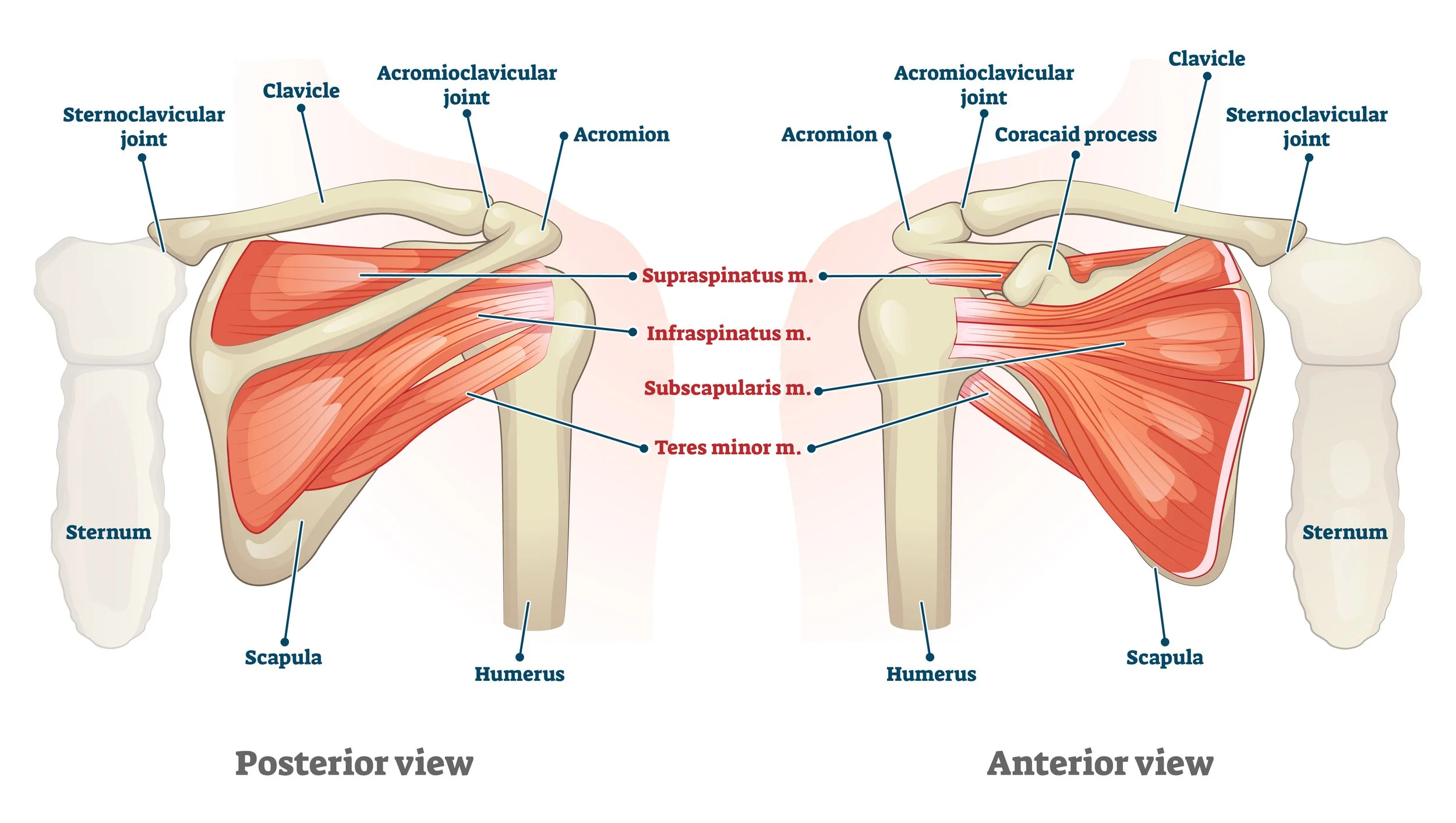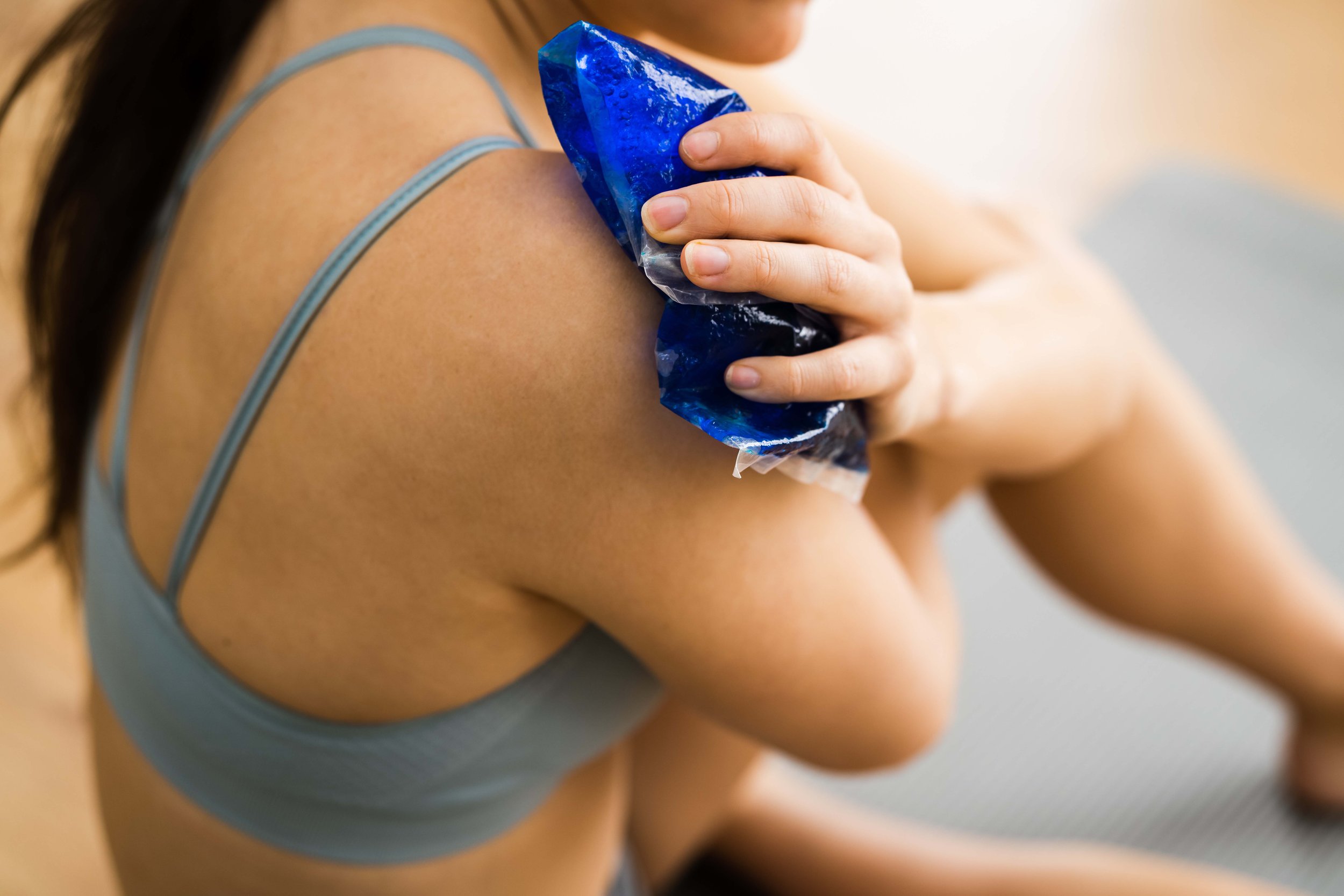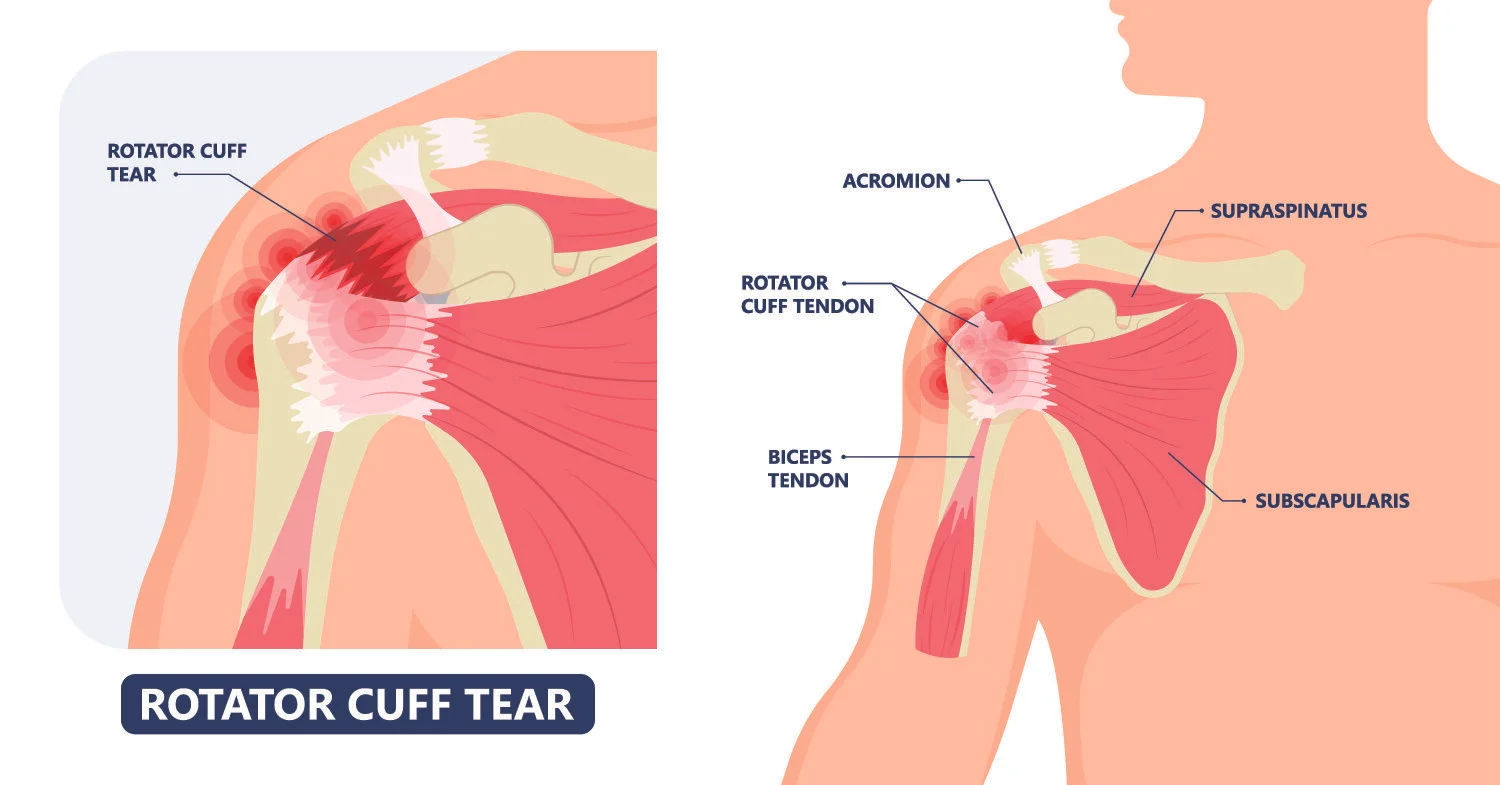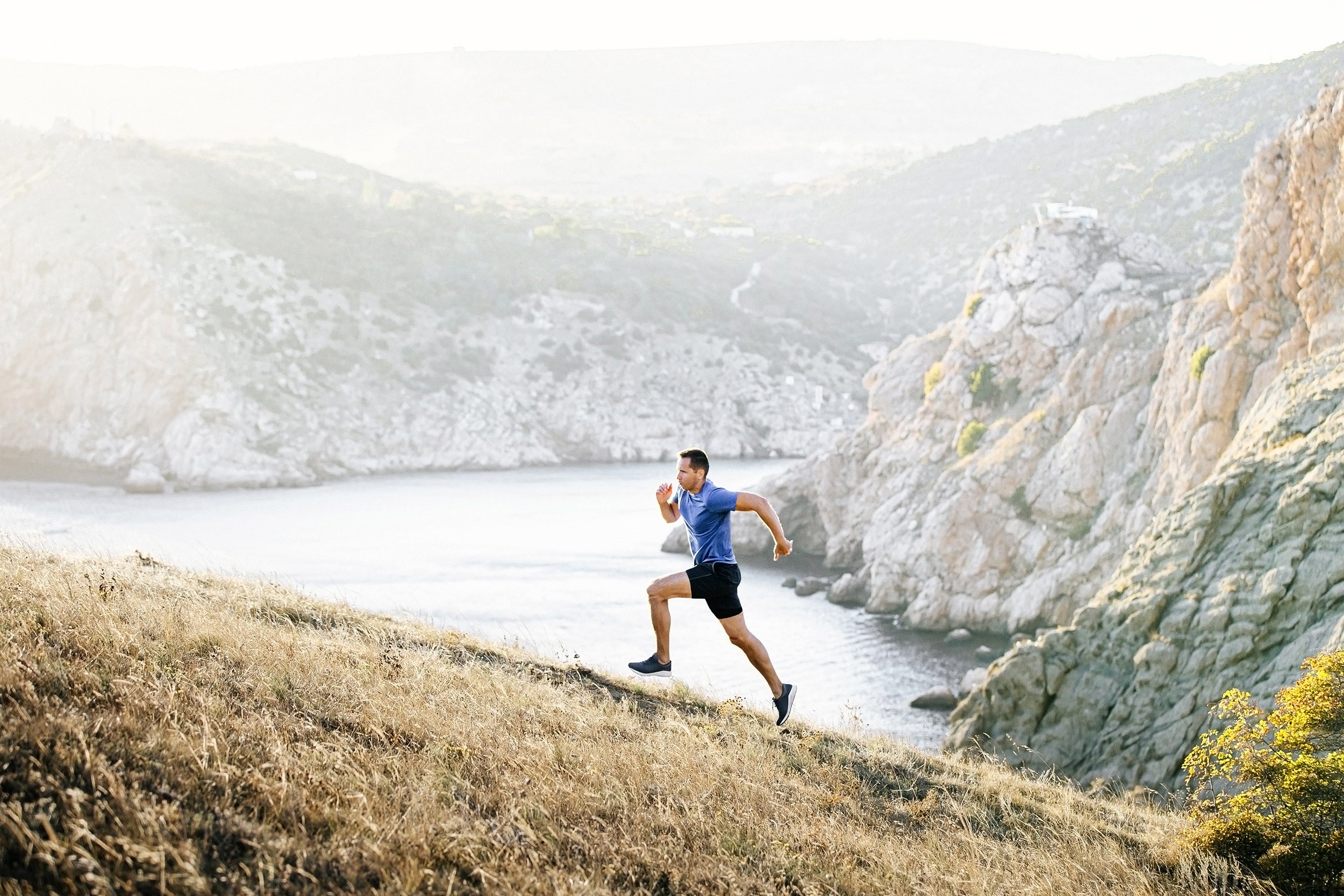What is the Healting Timeline
of the rotator Cuff?
it depends…
What Muscles or tendons of the rotator cuff are injured?
A big determining factor in the healing timeline is determining which tissues are affected. This will make a big difference in prognosticating what to expect with your injury. Here are some general guidelines in the healing of tissue. Keep in mind diet, exercise, pre-existing conditions, fitness, smoking, genetics, age, and sleep all play an active role in the arc of healing.
Muscle Tear Healing Timeline:
Muscles typically heal a little quicker than other tissues as they are highly vascular receiving oxygen and other nutrients throughout the day passively and even more during activation of the specific muscle and globally.
Grade I
2 days - 4 weeks
Grade II
3 weeks- 12 weeks
Grade III
5 weeks - 24 weeks
Ligament Tear Healing Timeline:
Ligaments are less vascular structures and rely on surrounding tissues and system blood flow to provide the healing to the tissue.
Grade I
4 days - 4 weeks
Grade II
3 weeks- 18 weeks
Grade III
5 weeks - 50 weeks
Surgical Protocols and Healing Timeline:
We took all the protocols that our local physicians used and created the mean for the average surgery. Of course the more extensive the tear and the more procedures done the slower the recovery and the longer the timeline to return to your goals.
Rehabilitation Program:
Rotator Cuff Repair (Small-Medium Tears)
Phase I (0-6 weeks)
Goals
Maintain/ protect integrity of repair , Gradually increase PROM , Diminish pain and inflammation, Prevent muscular inhibition, Maintain good upright shoulder posture
Precautions
Maintain arm in sling, remove only for shower or exercise
No shoulder AROM, lifting greater than 5 lbs, shoulder motion behind back, excessive
stretching or sudden movements, lifting body weight by hands
Phase II (6-12 weeks)
Goals
Allow healing of soft tissue , Do not overstress healing tissue, Gradually restore full PROM and AAROM by six weeks, Decrease pain and inflammation, Be vigilant for adhesive capsulitis
Phase III (12-16 weeks)
Goals
Full AROM , Maintain PROM, Dynamic shoulder stability, Gradual restoration of shoulder strength, power, and endurance, Optimize neuromuscular control, Gradual return to functional activities
Phase IV (16 weeks to 9 months)
Goals
Maintain full non-painful AROM , Improve muscular strength, power, and endurance , Gradual return to full functional activities, Initiate interval return to sport program (return to throwing, swimming, and other overhead activities)
What is the quickest way to heal?
The short answer is to have an evaluation with a physical therapist and determine the following.
When did the injury occur?
Your PT will determine a possible prognosis when a date of injury is identified
Was the injury one that was a slow chronic development or related to trauma?
Was this something that happened during a CrossFit workout or something that developed from your new work from home setup?
Which tissues are currently injured?
Your PT will take your involved and uninvolved shoulder through a battery of tests. These movements will determine what is normal Range of Motion (ROM), strength, neurological tension, and flexibility for you. Your results will then also be compared vs normative data. The clinician will also determine what provokes your pain and what tissues are involved.
If it appears that your injury is outside the ability of physical therapy to help you, then we won’t sit idly by. Our team has a lengthy group of Orthopedists we can call upon and connect you with directly this may involve x-rays, MRIs, and Diagnostic Ultrasound.
Our goal is to have a definitive diagnosis to allow you a lens into what to expect and what procedures will be most effective to help you meet you goals as quickly and as safely as possible.
Almost every insurance allows you to come directly into physical therapy. This is called direct access and came into law in the 1990s.
RELATED WEBINARS
RELATED BLOG ARTICLES
What Muscles makes up the rotator cuff?
The rotator cuff consists of four muscles; the subscapularis, supraspinatus, infraspinatus, and the teres minor. These muscles work together to act as dynamic stabilizers for the shoulder complex. They also assist in the normal mechanics of the shoulder joint by depressing the head of the humerus when raising the arm overhead, which helps prevent impingement from occurring.
The rotator cuff is a very fundamental muscle group to allow for reaching over head into cabinets, weightlifting, picking up kids. lifting groceries, walking a dog, throwing, swimming, and even helping push up from a chair.
What is the main function of the rotator cuff?
During arm movements, the rotator cuff contracts and prevents the sliding of the head of the humerus, allowing full range of motion, and providing overall joint stability. The rotator cuff also helps in the mobility of the shoulder joint by facilitating abduction (lifting arm to the side), medial or internal rotation (toward the belly), and lateral or external rotation (to the outside).
Rotator cuff tears typically occur at the junction where the tendon attaches to the bone and are can be caused by both extrinsic (outside) and intrinsic (inside) factors. More on Rotator Cuff Tears
More Shoulder Articles & FAQs
What Exercises Are Bad for the Rotator Cuff?
How Can I tell If I Have a Strain or Torn Rotator Cuff?
What Are the Tests for a Rotator Cuff Tear?
Do I need an MRI or MRI Arthrogram for my Shoulder?
What is Wrong With My Shoulder?
What is Rotator Cuff Tendinitis?
Contributing Authors:
Mark Bouma, PT, DPT, OCS,COMT,FAAOMPT,CSCS
Heidi Biehl, PT, DPT, OCS, CSCS, CFSC
Matt Sato, PT, TPIc, SFMA
Benjamin Wobker, PT, MSPT, CSCS, SFMA
Joe nance, PT, MPT, OCS, COMT, FAAOMPT, ATC
DR. Samuel Koo, MD
DR. Jamie Antoine, MD
Dr. Vincent Santoro, MD
Dr. Camile Clinton, MD
Dr. Bob AdamS, DO
Dr. Christian Peterson, DO
DR. Chris Wahl, MD
Dr. Dayne Mickelson, MD
DR. Tyler Nathe, MD
Dr. Thomas CastLe,MD
Dr. Michael Sailer, MD
Dr. Greg Komenda, MD
References:
Orthopedic Physical Assessment, 4th Edition. David J. Magee, 2006. www.emedicine.medscape.com/article/93095-overview
Kim TK, et al. "Clinical features of the different types of SLAP lesions" Journal of Bone Joint Surgery Am. 2003 Jan;85-A(1):66-71. http://emedicine.medscape.com/article/1261463-overview
Mayo Clinic: Rotator Cuff; https://www.mayoclinic.org/diseases-conditions/rotator-cuff-injury/symptoms-causes/syc-20350225
WebMD: Rotator Cuff; https://www.webmd.com/pain-management/qa/what-causes-rotator-cuff-problems
Disclaimer:
This website is an information and education resource for health professionals and individuals with injuries. It is not intended to be a service for patients and should not be regarded as a source of medical or diagnostic determination, or used as a substitute for professional medical instruction or advice. Not all conditions and treatment modalities are described on this website. Any liability (in negligence or otherwise) arising from any third party acting, or refraining from acting, on any information contained on this website is hereby excluded.








